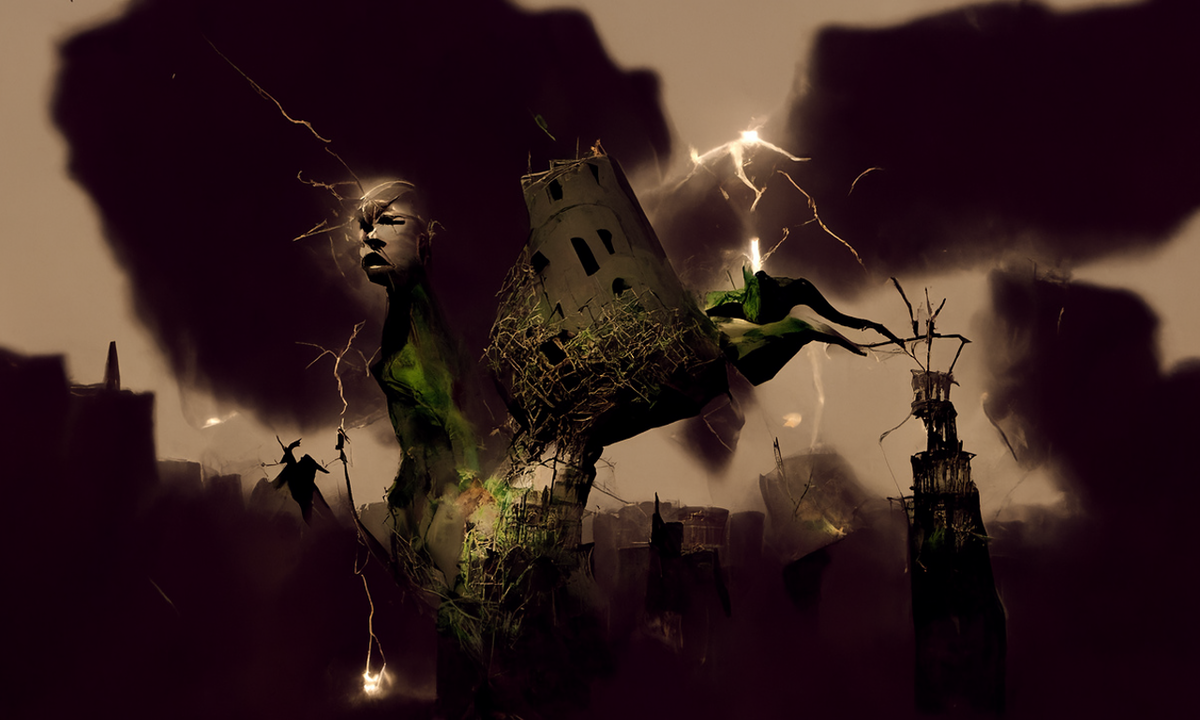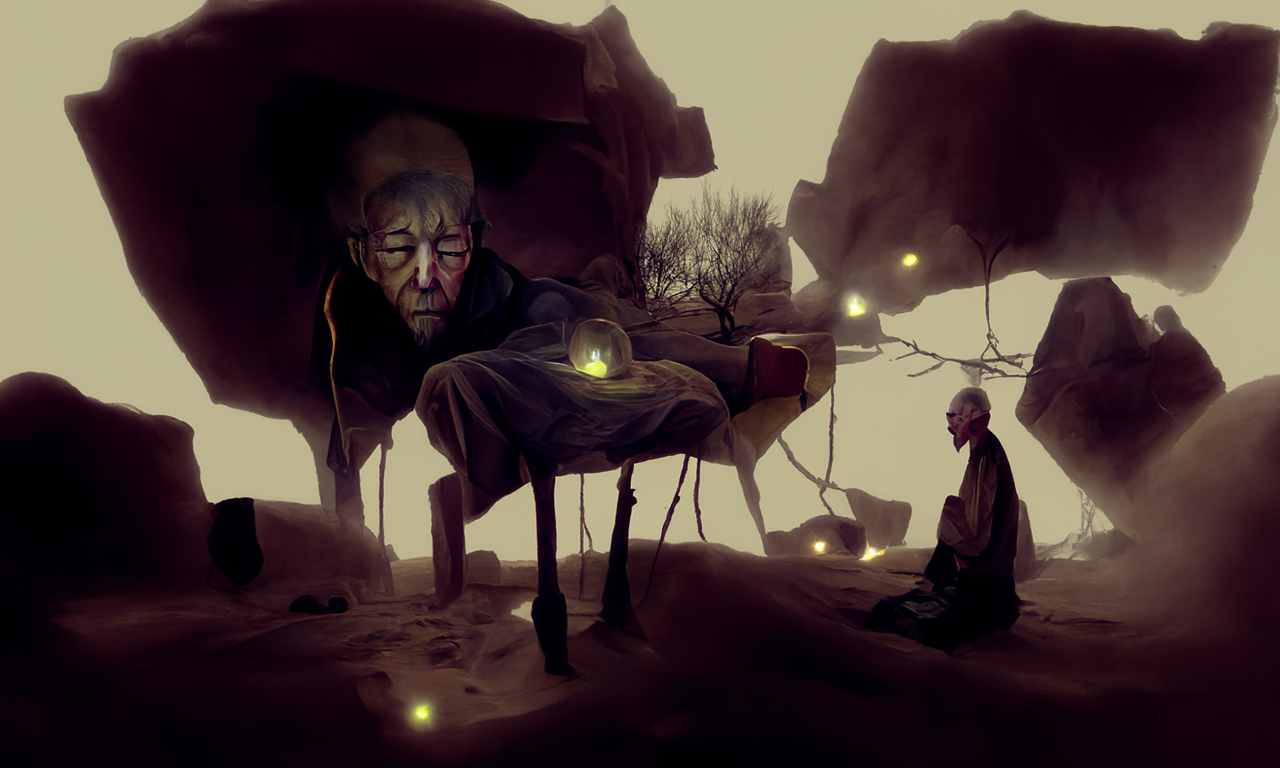Life, life support, and the afterlives of (im)possible worlds
How can stories, scenarios, and situations enhance agency amid chaotic circumstances? Setting the stage for improvisational and palliative futures, among other possibilities for surrendering to and moving through uncertainty.
Excerpts adapted from the lecture-performance at the “Bringing Futures Back to Life” symposium, performed in Vienna, May 2022.
Time flows and stories flow, acquiring their fluid cacophony of relations. Stretching, breaking, weaving, and reforming, with no absolute origin or point of disappearance. A tangle of propositions flickering in and out of existence, connections emerging and subsiding — echoes long past, becoming premonitions of that which will come to pass, recurring over and again. Time becomes momentary, becomes cyclic, time slips from the now into the now… and the now.

Agency amid chaotic change
Beneath the screen and beyond the pages of the book, other worlds flicker. A seething of conspiracies, the half-bakery boiling over with partial truths, easy explanations, and sticky brainworms, ravenous and reeling. Cutting through it all, a shimmering of kindred imaginaries, of hopeful futures brought to life; glimmers of the possible in the gestures of the mundane.
As you read this, you are surrounded by contradictory stories, some shared, some singular, fleeting and fragile. Others are so large that you can barely make out the curve of their narrative arc, as they seep, unnoticed, into your everyday. To navigate these stories, words and worlds, you might reach for new tools to complement your habitual techniques. These tools can be augmented, new habits can be formed, overwriting the old. You can rely on secrets whispered by friends, the cauldron of facts and fiction, the additive layers of scientific analysis, or a myriad of performative ways of being in the world. But even that might not be enough.
Many of us experience the everyday as we tumble from one urgency to another, lacking the time, opportunity, or motivation to build a coherent narrative. We make decisions with incomplete information, and face unintended consequences. Instead of meticulously forging a perfect strategy, living with uncertainty requires honing our skills of adaption, adjusting to changing internal pressures and external circumstances. These skills are familiar to those of us who’ve faced prolonged exposure to chronic uncertainty, whether through illness, conflict, migration, natural disasters, economic precarity, or systemic discrimination.
Others’ adaptive capacity may have atrophied over decades with an excess of certainty. Adapting to an unfamiliar, uncomfortable situation can feel like an attack on one’s “freedom” to continue with business as usual. Think of the incessant demands to “return to normal” during the Covid-19 pandemic, no matter the cost, or who and what else this normality would require us to sacrifice.
What are some other ways we could cope with the increasing complexities of daily life in the worlds we inhabit? How can we rehabilitate a sense of agency amid chaotic change?

One approach is to work with futuring on a micro scale, with individuals, families, and collectives. To translate formal, established futures methods into conversational techniques. To combine futuring with active listening, coaching, improvisation, and meditation (for example). Then translate these conversations into real-life experiments and future prehearsals.Prehearsals & pre-enactments
Simple futuring interventions in people’s lives can work like acupuncture, unblocking energetic flows, revealing latent possibilities that were already present. These interventions begin and end in daily life, acting “as if” a future already happened, and noticing how this affects the form and feel of relationships, routines, infrastructure, and ideas. Such interventions can take days, months, or years, as the situation demands.
A ship transforms into a mobile home and a post-national performance venue.
Admin becomes RADMIN
A school called HOME.
These are spaces for propositions to germinate; nurseries for seeding futures still too fragile to be planted in open ground. At small scale, and with limited resources, these futures can begin to sprout. Until they can be transplanted into the wilder places beyond, where they will face exposure to the complex uncertainties of the here and now.

Living with chronic uncertainty
Most of us can find ways to live with uncertainty, while treating its immediate symptoms. Sometimes, it's possible to address its root causes. To take one example, the uncertainty of a pandemic might manifest in your daily life as less predictable, more frictive travel conditions — cancellations, queues, and the like. Rather than succumbing to paralysis, anxiety, or outrage, you can “treat” this symptom in your life by deciding not to travel, or walking places, or setting aside additional time and resources as buffers for long-distance travel. If you’re working in medical research or the transport sector, you might be able to address the underlying root causes, by developing a vaccine or a more resilient railway network, but this will be beyond most people’s abilities, resources, and control. Sustained periods of instability can feel like a chronic condition, with no hope of a cure. In such situations, it is worth acquiring a working knowledge of some emergency protocols for “surviving well together”. Tactics and practices of triage, mutual aid, radical compassion, and nonviolent resistance. Knowing when to run and hide, to retreat and regroup, surviving to fight another day.
Contrary to the proactive “can-do” attitude prevalent in much futures work, “giving up” does not have to mean defeat. Giving up can be the wisest response to an otherwise insurmountable situation. “Giving up” on what can't be changed to create space for new possibilities.
Applying palliative care to possible futures can provide comfort by reducing—rather than trying to eliminate—the most distressing symptoms of volatility, uncertainty, complexity, and ambiguity in everyday life. Compassionately guiding things to their end, finding a conscious closure. A via negativa, knowing what not to do. Knowing what to remove, knowing how to work with less, knowing when to abandon what you think you know. Knowing when to start again.

When circumstances become too hostile, some futures may need a refuge from the world. A sanatorium for the injured, unwanted, and endangered futures that cannot exist in the present. With intensive care and life support, futures that are currently unattainable—blocked by hostile circumstances —can be rehabilitated and renewed, invigorated by a steady trickle of reciprocal relationships and resonant ideas. Convivia, Refugia. Not Always Everywhere. But, as palliative carers know, sometimes neither further exposure nor removal from the world are enough.
Sometimes, impossible worlds and unconventional futures fade away, passing on to an afterlife in the propositional penumbra. And yet, they continue to exist in you, as beloved imaginaries, memories, hopes, invocations of lives that might yet still be. They abide, patiently awaiting your attention; your care. They’ll appear in the routines of the everyday, and on the frontline of cultural change. A resistance, a quickening. A quivering of the invisible strings that bind life to itself.

Prismatic Refractions.
For these futures to be brought back to life, partial attention—an hour every now-and-again, or a few days here-and-there—cannot be enough. They demand more, needing intensive care to transition into life or dissolve deeper into the afterlife. Long-term life support. For (im)possible stories and situations, echoes and premonitions.
Here, and now, and tomorrow. Quietly, persistently, drawing your attention.
Can you hear it? What are you hearing? Just... listen.
🝓